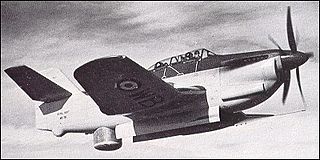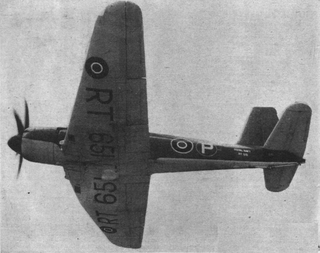Related Research Articles

Blackburn Aircraft Limited was a British aircraft manufacturer from 1914 to 1963 that concentrated mainly on naval and maritime aircraft.

The Blackburn Roc was a naval fighter aircraft designed and produced by the British aviation company Blackburn Aircraft. It took its name from the mythical bird of the tales of the Arabian Nights, the Roc. It was operated by the Fleet Air Arm (FAA) and was active during the Second World War.

The Saunders-Roe SR.A/1 was a prototype flying boat fighter aircraft designed and built by British seaplane manufacturer Saunders-Roe. It was the first jet-propelled water-based aircraft in the world.

The Blackburn B-24 Skua was a carrier-based low-wing, two-seater, single-radial engine aircraft by the British aviation company Blackburn Aircraft. It was the first Royal Navy carrier-borne all-metal cantilever monoplane aircraft, as well as the first dive bomber in Fleet Air Arm (FAA) service. The aircraft took its name from the sea bird which 'divebombs' any potential predators that come too close to its nest.

The Saunders Roe A.27 London was a British military biplane flying boat built by the Saunders Roe company. Only 31 were built, entering service with the Royal Air Force (RAF) in 1936. Although due for replacement by the outbreak of World War II, they saw some active service pending the introduction of the ultimately unsuccessful Lerwick.

The Saunders-Roe A.36 Lerwick was a British flying boat built by Saunders-Roe Limited (Saro). It was intended to be used with the Short Sunderland in Royal Air Force Coastal Command but it was a flawed design and only a small number were built. They had a poor service record and a high accident rate; of 21 aircraft, 10 were lost to accidents and one for an unknown reason.

The Saunders-Roe SR.53 was a British prototype interceptor aircraft of mixed jet and rocket propulsion developed for the Royal Air Force (RAF) by Saunders-Roe in the early 1950s. As envisaged, the SR.53 would have been used as an interceptor aircraft, using its rocket propulsion to rapidly climb and approach incoming hostile bombers at high speeds; following its attack run, the aircraft would then return to its base using jet propulsion.
The Society of British Aerospace Companies was the UK's national trade association representing companies supplying civil air transport, aerospace defence, homeland security and space. As of October 2009 SBAC merged with the Defence Manufacturers Association and the Association of Police and Public Security Suppliers to form the ADS Group.

The Blackburn B-20 was an experimental aircraft, first flying in 1940, that attempted to drastically increase the performance of flying boat designs. Blackburn Aircraft undertook an independent design study based on a patent filed by their chief designer, John Douglas Rennie for a retractable pontoon float that formed the planing hull.

The Blackburn B-54 and B-88 were prototype carrier-borne anti-submarine warfare aircraft of the immediate post-Second World War era developed for the Royal Navy's Fleet Air Arm (FAA). They shared a conventional monoplane design with a mid-mounted inverted-gull wing and tricycle undercarriage. The pilot and observer sat in tandem under a long canopy atop the fuselage. The B-54 had a piston engine while the B-88 had a gas turbine driving large contra-rotating propellers. The radar scanner was mounted in a retractable radome in the rear fuselage, behind a long internal weapons bay. The program was cancelled in favour of the Fairey Gannet aircraft.

The Fairey Spearfish was a British carrier-based, single-engined, torpedo bomber/dive bomber that was ordered from Fairey Aviation for the Fleet Air Arm during World War II. Designed during the war, the prototype did not fly until July 1945. Much larger than earlier naval bombers, it was designed for use aboard the large Malta-class aircraft carriers that were cancelled after the war and was itself cancelled thereafter. Seven prototypes were ordered, but only five were built, of which four actually flew. They were mostly used for experimental work until the last aircraft was scrapped in 1952.

The British Martin-Baker MB 5 was the ultimate development of a series of prototype fighter aircraft built during the Second World War. Neither the MB 5 nor its predecessors ever entered production, despite what test pilots described as excellent performance.

The Blackburn Firebrand was a British single-engine strike fighter for the Fleet Air Arm of the Royal Navy designed during World War II by Blackburn Aircraft. Originally intended to serve as a pure fighter, its unimpressive performance and the priority allocation by the Ministry of Aircraft Production of Napier Sabre engines to the Hawker Typhoon caused it to be redesigned with an alternate engine as a strike fighter to take advantage of its load-carrying capability. Development was slow and the first production aircraft was not delivered until after the end of the war. Only a few hundred were built before it was withdrawn from front-line service in 1953.

Operational Requirement F.155 was a specification issued by the British Ministry of Supply on 15 January 1955 for an interceptor aircraft to defend the United Kingdom from Soviet high-flying nuclear-armed supersonic bombers.
The Short Shetland was a British high-speed, long-range, four-engined flying boat built by Short Brothers at Rochester, Kent for use in the Second World War. It was designed to meet an Air Ministry requirement for a very-long range reconnaissance flying boat. The design used the company's experience with large scale production of the Short Sunderland. The end of World War II prevented the Shetland from entering production. It was the first aircraft designed with a 110 volt electrical system.

The Blackburn B.48 Firecrest, given the SBAC designation YA.1, was a single-engine naval strike fighter built by Blackburn Aircraft for service with the British Fleet Air Arm during the Second World War. It was a development of the troubled Firebrand, designed to Air Ministry Specification S.28/43, for an improved aircraft more suited to carrier operations. Three prototypes were ordered with the company designation of B-48 and the informal name of "Firecrest", but only two of them actually flew. The development of the aircraft was prolonged by significant design changes and slow deliveries of components, but the determination by the Ministry of Supply in 1946 that the airframe did not meet the requirements for a strike fighter doomed the aircraft. Construction of two of the prototypes was continued to gain flight-test data and the third was allocated to strength testing. The two flying aircraft were sold back to Blackburn in 1950 for disposal and the other aircraft survived until 1952.

The Fairey Pintail was a British single-engine floatplane fighter of the 1920s. While it was developed by Fairey as a reconnaissance fighter for the Royal Air Force, the only orders placed were for three for the Imperial Japanese Navy.

The Avro Type 557 Ava was a British twin-engined biplane torpedo bomber of the 1920s. It was developed by Avro to meet a requirement for a heavy torpedo bomber for the Royal Air Force but was unsuccessful, only two prototypes being built.

The Saunders A.14 was a test aircraft for Saunders' new metal hull construction method, being a Supermarine Southampton fitted with the Saunders' fuselage. The methods tested worked well enough to be used in SARO flying boat production from 1928 to 1938.
The Supermarine Type 324 and Type 325 were British two-engined fighter designs proposed as the replacement for the Supermarine Spitfire and Hawker Hurricane. Neither of them nor a revised design - the Type 327 - to carry cannon was accepted for development and production.
References
Notes
- ↑ Buttler 2012, p. 16
Bibliography
- "Blackburn B20, B40 and B44". Air-Britain Aeromilitaria. Vol. 33, no. 130. Summer 2007. pp. 65–68. ISSN 0262-8791.
- Buttler, Tony (2012). British Experimental Combat Aircraft of World War II: Prototypes, Research Aircraft and Failed Production Designs. Manchester, UK: Hikoki Publications. ISBN 978-1902-109244.
- Buttler, Tony (2004). British Secret Projects: Fighters & Bombers 1935–1950. Hinkley, UK: Midland Publishing. ISBN 1-85780-179-2.
- Meekcoms, K. J; Morgan, E. B. (1994). The British Aircraft Specification File. Air-Britain Publications. ISBN 0-85130-220-3.
- Jackson, A. J. (1968). Blackburn Aircraft since 1909. London: Putnam. ISBN 0370-000536.